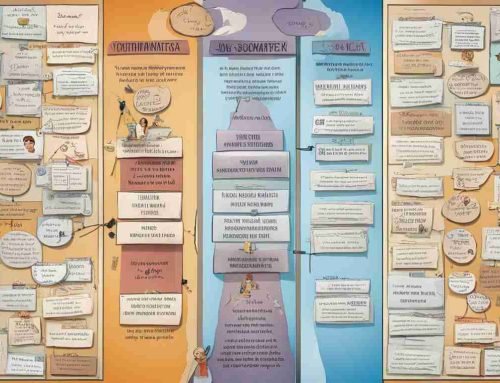Introduction To The 4 Types of Extrinsic Motivation
Extrinsic motivation is engaging in activities or behaviors to attain external rewards or avoid punishment. These rewards can include tangible things, such as money or gifts, and intangible benefits, like praise or recognition. In contrast to intrinsic motivation, which stems from internal factors such as personal interests or enjoyment, extrinsic motivation relies on external factors to encourage and propel individuals to act.
1. External Regulation
External regulation is the most basic and externally driven type of extrinsic motivation. It involves engaging in a behavior solely because of an external reward or punishment. Externally regulated individuals are primarily motivated to avoid negative consequences or gain specific rewards.
For example, an employee might work diligently on a project solely because they fear reprimand or hope to receive a bonus. In this case, their behavior is contingent upon external factors rather than internal interest or enjoyment.
External regulation might lead to dependency: While it might be effective in the short-term, external regulation could lead to a dependency on rewards or fear of punishment. This can potentially hinder the development of a person’s internal motivation.
Expanding on :
- External regulation can be effective when immediate compliance is necessary, such as enforcing safety protocols in hazardous work environments.
- This type of motivation is often short-term and can lead to a lack of intrinsic motivation if overemphasized.
- To sustain external regulation, it is essential to consistently provide clear incentives and rewards while ensuring that non-compliance consequences are communicated.
Examples of External Regulation
- A student who studies hard solely to get good grades or avoid failing
- An employee who works hard to keep getting their paycheck
- A child who cleans their room only to avoid getting in trouble with parents
- A person who runs 5 miles only to win a contest prize
- A team who works weekends to hit targets and earn bonuses
2. Introjection
Introjection is a slightly more internalized form of extrinsic motivation. It occurs when individuals engage in a behavior to avoid feelings of guilt or to enhance their self-esteem. While motivation stems from outside influences, such as societal expectations or personal standards, individuals in this category have partially internalized the behavior.
The Importance of emotional well-being: While introjection can be a strong motivator, the individual’s emotional well-being must be considered. This type of motivation relies on emotions such as guilt or pride, so it can lead to stress and anxiety if not handled well.
An example of introjection can be seen when someone volunteers for a charity event to be perceived as a good person or to alleviate personal guilt. Their motivation is driven by a desire to enhance their self-image and avoid negative emotions, but external factors still influence it.
Expanding on Introjection:
- Introjection can be a powerful motivator in situations where individuals value the opinions of others or seek to maintain a positive self-image.
- Creating an environment that fosters self-acceptance and encourages individuals to engage in behaviors that align with their values and beliefs is vital.
- By promoting a sense of intrinsic satisfaction and fulfillment through introjection, individuals can be motivated to continue engaging in desired behaviors even when external rewards are not present.
Examples of Introjection motivation
- A student who studies hard to avoid feeling shame or guilt
- An employee who works weekends because they want the approval of their manager
- A child who cleans their room to avoid letting parents down
- A person who runs daily to avoid feeling like a failure
- A team that takes on extra work to appear dedicated
3. Identification
Identification involves engaging in a behavior because it aligns with one’s values, goals, or aspirations. Individuals motivated by identification link the behavior to their self-identity and view it as relevant to their values and beliefs.
Importance of values alignment: Identification becomes powerful when personal and external values align perfectly. For instance, employees might feel more motivated if the company’s mission resonates with their personal beliefs.
For instance, a person might pursue a career in environmental activism because they genuinely care about protecting the planet and preserving nature. Their motivation is intrinsically tied to their values and beliefs, even though external factors may have initially sparked their interest.
Expanding on Identification:
- Identification can be a powerful source of motivation as it taps into an individual’s sense of purpose and aligns their actions with their core values.
- To leverage identification, it is vital to provide opportunities for individuals to connect their values and goals with the tasks or behaviors at hand.
- By emphasizing the relevance and importance of the behavior to their self-identity, individuals are more likely to be motivated intrinsically, leading to sustained engagement and commitment.
Examples:
- A student who studies hard because they see it as beneficial for their career
- An employee who takes leadership roles to advance their skills
- A child who cleans their room because they value a tidy space
- A person who runs daily because fitness is important to them
- A team that volunteers after hours to support a cause they believe in
4. Integration
Integration is the highest level of internalization within extrinsic motivation. It occurs when individuals fully integrate and assimilate a behavior into their self-identity and perceive it as congruent with their authentic selves. They engage in the behavior willingly, finding personal satisfaction and fulfillment.
Nurturing the state of flow: When individuals reach the stage of integration, they might experience a state of flow where they’re fully absorbed in the activity they’re engaged in. This state can lead to higher levels of productivity and satisfaction.
An example of integration can be seen in an individual who consistently participates in marathons or athletic competitions because they genuinely enjoy the physical challenge, the sense of accomplishment, and the camaraderie among fellow participants. Their interest and satisfaction entirely drive their motivation.
Expanding on Integration:
- Integration represents the highest level of extrinsic motivation, where individuals find genuine enjoyment and fulfillment in the behavior.
- Creating an environment that allows individuals to explore their interests and passions and engage in activities that align with their authentic selves is essential to foster integration.
- By encouraging autonomy and providing opportunities for mastery and purpose, individuals can be motivated to fully integrate the behavior into their self-identity, leading to sustained engagement and personal growth.
Examples:
- A student who studies hard because being educated is part of who they are
- An employee who works weekends because it fits their identity as a leader
- A child who cleans their room to have an organized living space
- A person who runs daily because being athletic is central to their self-image
- A team that volunteers on weekends because service is part of their team culture
5. Leveraging the Four Types of Extrinsic Motivation
Understanding the various types of extrinsic motivation allows us to tailor approaches to drive behavior change and encourage desired actions effectively. Here are some strategies to leverage these motivations in different contexts:
In the Workplace
- External Regulation: Provide clear incentives and rewards for desired behaviors, such as bonuses or promotions.
- Communicate the rewards and consequences associated with specific behaviors to motivate employees.
- Regularly evaluate and update the incentive system to ensure it remains relevant and meaningful to employees.
- Introjection: Promote a supportive and inclusive work environment that fosters a sense of belonging and positive self-esteem.
- Encourage open communication and allow employees to voice their opinions and ideas.
- Recognize and appreciate individual contributions to create a positive work culture.
- Identification: Align organizational values and goals with those of the employees, emphasizing shared purpose and mission.
- Communicate the organization’s vision and values to employees, ensuring they understand how their work contributes to the overall mission.
- Provide opportunities for employees to connect their values and goals with the organization’s objectives.
- Integration: Encourage autonomy, mastery, and purpose in job roles, allowing employees to engage and find personal fulfillment in their work thoroughly.
- Provide opportunities for skill development and growth to empower employees to take ownership of their work.
- Foster a culture that encourages innovation and allows employees to explore their interests and passions within their roles.
In Education
- External Regulation: Utilize reward systems, such as stickers or certificates, to motivate students to complete tasks or achieve academic goals.
- Clearly define the rewards and criteria for earning them to provide students with a clear understanding of what is expected.
- Regularly acknowledge and celebrate students’ achievements to reinforce positive behavior.
- Introjection: Foster a classroom environment that promotes intrinsic motivation by emphasizing the importance of personal growth and learning.
- Encourage students to set personal goals and reflect on their progress.
- Provide constructive feedback that focuses on effort and improvement rather than just grades.
- Identification: Connect students’ interests and aspirations to the curriculum, making the content relevant and meaningful to their lives and future goals.
- Incorporate real-world examples and applications of the curriculum to demonstrate its relevance.
- Provide opportunities for students to explore topics of personal interest within the curriculum.
- Integration: Encourage student autonomy and provide opportunities for self-directed learning, allowing them to explore personal interests and passion topics.
- Offer project-based learning opportunities that allow students to pursue their inquiries and interests.
- Provide resources and support for students to engage in independent research and exploration.
In Personal Development
- External Regulation: Set tangible rewards or penalties for achieving or failing to meet personal development goals.
- Clearly define personal development goals and establish meaningful and motivating rewards to the individual.
- Establish consequences for not meeting personal development goals to provide accountability.
- Introjection: Reflect on personal values and beliefs to identify areas of improvement and align goals with self-growth.
- Engage in self-reflection to identify personal values and areas for personal growth.
- Set goals aligning with values and focus on personal development and improvement.
- Identification: Connect personal goals with long-term aspirations, emphasizing how they contribute to one’s overall sense of purpose and fulfillment.
- Identify long-term aspirations and determine how personal goals contribute to their achievement.
- Regularly revisit personal goals and aspirations to align with one’s sense of purpose and fulfillment.
- Integration: Engage in activities and behaviors that align with personal passions and interests, allowing for genuine enjoyment and self-fulfillment.
- Prioritize activities and behaviors that align with personal passions and interests.
- Seek opportunities to engage in activities that provide a sense of accomplishment and fulfillment.
By understanding and harnessing the power of the four types of extrinsic motivation, individuals and organizations can create environments that foster motivation, engagement, and achievement. Whether in the workplace, education, or personal development, tailoring approaches to leverage these motivations can lead to more tremendous success and satisfaction in various aspects of life.
6. The Pros and Cons Of The 4 Types Of Extrinsic Motivation
| Motivation Type | Autonomy | Pros | Cons |
|---|---|---|---|
| External Regulation | Low | Results from clear rewards and consequences | Lack of internalization, feelings of control |
| Introjected Regulation | Medium | Some internalization of values | Still high external perceived control |
| Identified Regulation | Moderately High | Conscious valuing of behavior | Contingent on external outcomes |
| Integrated Regulation | High | Aligned with identity and values | Requires high self-awareness |
7. FAQ
1. What is extrinsic motivation?
Extrinsic motivation is engaging in activities or behaviors to attain external rewards or avoid punishment. It relies on external factors to encourage individuals to act.
2. What is the difference between external regulation and introjection?
External regulation involves engaging in a behavior solely because of an external reward or punishment. At the same time, introjection occurs when individuals behave to avoid guilt or enhance their self-esteem.
3. How does identification differ from integration?
Identification involves engaging in a behavior because it aligns with one’s values and beliefs. At the same time, integration occurs when individuals fully integrate behavior into their self-identity and find personal satisfaction.
4. How can the four types of extrinsic motivation be leveraged in the workplace?
- External Regulation: Provide clear incentives and rewards for desired behaviors.
- Introjection: Promote a supportive and inclusive work environment.
- Identification: Align organizational values and goals with those of the employees.
- Integration: Encourage autonomy, mastery, and purpose in job roles.




